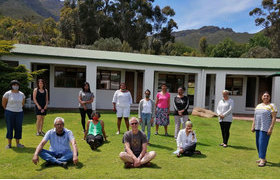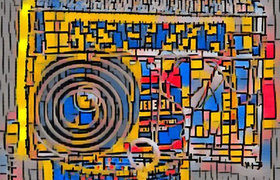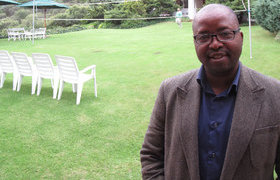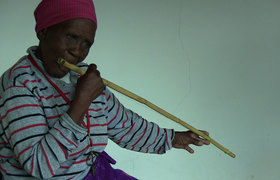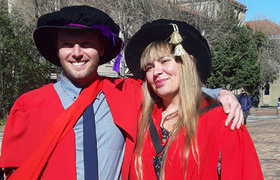New giant dinosaur: an evolutionary experiment
04 October 2018 | Story Staff writer. Photo Viktor Radermacher. Read time 6 min.
A new species of a giant dinosaur found in South Africa could challenge theories about the evolution of four-legged walking, that is according to an international team of scientists, including a geologist at UCT. The newly discovered plant-eating dinosaur named Ledumahadi mafube weighed in at 12 tonnes and stood about four metres high at the hips – about double the size of a large African elephant.
UCT Associate Professor Emese Bordy was part of the team, which also included researchers from the University of the Witwatersrand, Oxford University and the South African National Museum. Brody is a geologist specialising in sedimentary rocks – which form through the deposition of particles under water bodies, such as oceans or rivers – and stratigraphy – the layers and layering of rocks.
The team’s findings were published in an article in the journal Current Biology.
Jurassic giant
The dinosaur – whose name means ‘a giant thunderclap at dawn’ in Sesotho – was the largest land animal on Earth when it lived nearly 200 million years ago during the earliest part of the Jurassic period. L. mafube roamed in what is now a scenic mountainous area around Clarens in the Free State but was then a flat, semi-arid landscape with shallow, intermittently dry streambeds.
The finding of this new dinosaur – bigger than any previously known to exist in this area – represents a scientific milestone not only for what L. mafube can tell us about its species and habitat, but also about how other dinosaurs evolved.
The story of this ancient environment was told by Associate Professor Bordy, whose contribution to the research was to interpret the clues captured in the Jurassic rock layers surrounding the dinosaur fossils and relate these rocks to their counterparts elsewhere in the world.
“I have been studying the sedimentology, stratigraphy and palaeontology of this southern African Jurassic park for the past 16 years,” says Bordy. “In the Early Jurassic, the area around Clarens looked a lot more like the current region around Musina in the Limpopo Province or the central Karoo in South Africa.
“For me, every new discovery we make is a new, exciting puzzle piece that helps us tell the story of this 200-million-year-old complex ecosystem with more clarity.”
The finding of this new dinosaur – bigger than any previously known to exist in this area – represents a scientific milestone not only for what L. mafube can tell us about its species and habitat, but also about how other dinosaurs evolved.
An experiment on four legs
Imagine a giant, herbivorous dinosaur and you will probably think of the classic Brontosaurus with its long neck, long tail and small head: the largest animal ever to have walked Earth. Dinosaurs like this are known as sauropods.
The earlier dinosaurs, which preceded sauropods, are known as sauropodomorphs and L. mafube is among those: similar to a sauropod, but actually a precursor of the sauropods.
The new method led the researchers to deduce that L. mafube walked on four legs, and hence, that quadrupedalism may have emerged among the sauropodomorphs 10 million years earlier than previously thought.
The earliest of the sauropodomorphs walked on two legs, and – up to now – many scientists believed their body plan limited their size. However, the team that discovered L. mafube argue that it walked on four legs, a finding that could alter understanding of how four-legged walking evolved in the lineage.
To understand how this dinosaur – and others – walked, the research team developed a new method that compares measurements of animals’ thigh and arm bones, based on similar measurements for other dinosaur specimens and hundreds of animals alive today. The new method led the researchers to deduce that L. mafube walked on four legs, and hence, that quadrupedalism may have emerged among the sauropodomorphs 10 million years earlier than previously thought.
Their theory posits that four-legged walking then disappeared before evolving again among the successful gigantic sauropods, such as Brontosaurus. As one of the sauropodomorphs that walked on four legs, L. mafube could have been a failed evolutionary experiment that happened before the group re-gained the ability later on.
A fossil heritage
South African Minister of Science and Technology Mmamoloko Kubayi-Ngubane says the discovery underscores how important South African palaeontology is to the world. “Not only does our country hold the Cradle of Humankind, but we also have fossils that help us understand the rise of the gigantic dinosaurs.
“This is another example of South Africa taking the high road and making scientific breakthroughs of international significance on the basis of its geographic advantage, as it does in astronomy, marine and polar research, indigenous knowledge, and biodiversity.”
 This work is licensed under a Creative Commons Attribution-NoDerivatives 4.0 International License.
This work is licensed under a Creative Commons Attribution-NoDerivatives 4.0 International License.
Please view the republishing articles page for more information.
Next Generation Professoriate (NGP)
The Next Generation Professoriate (NGP) is a mid-career academic staff development and support programme. Funded by the vice-chancellor’s Strategic Funds, the NGP addresses demographic inequalities in the academic hierarchy. The goal is to help members become associate and full professors.
The NGP was officially launched in September 2015. By the end of 2018, four of its members had been promoted to full professor and a further 14 had reached the rank of associate professor.
The programme is led by Dr Robert Morrell, who has over 35 years of academic experience in South African universities. He has a B1-rating from the the National Research Foundation (NRF) and is an elected member of the Academy of Sciences in South Africa.
Newsletters
In the news

